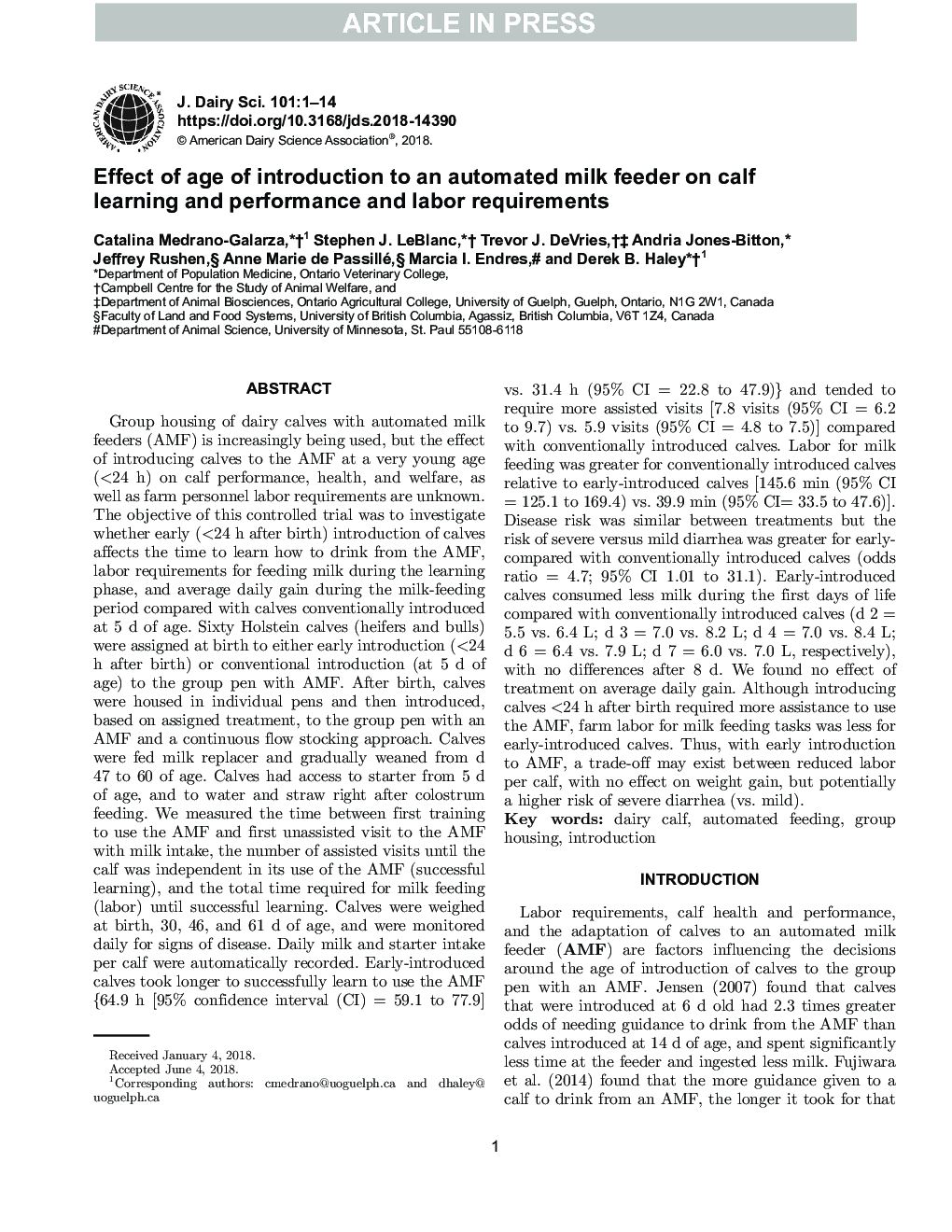| کد مقاله | کد نشریه | سال انتشار | مقاله انگلیسی | نسخه تمام متن |
|---|---|---|---|---|
| 10158096 | 1666505 | 2018 | 14 صفحه PDF | دانلود رایگان |
عنوان انگلیسی مقاله ISI
Effect of age of introduction to an automated milk feeder on calf learning and performance and labor requirements
ترجمه فارسی عنوان
تأثیر سن ورود به یک شیر تغذیه اتوماتیک بر یادگیری گوساله و عملکرد و الزامات کار
دانلود مقاله + سفارش ترجمه
دانلود مقاله ISI انگلیسی
رایگان برای ایرانیان
کلمات کلیدی
گوساله لبنی تغذیه خودکار، مسکن گروهی، معرفی،
موضوعات مرتبط
علوم زیستی و بیوفناوری
علوم کشاورزی و بیولوژیک
علوم دامی و جانورشناسی
چکیده انگلیسی
Group housing of dairy calves with automated milk feeders (AMF) is increasingly being used, but the effect of introducing calves to the AMF at a very young age (<24 h) on calf performance, health, and welfare, as well as farm personnel labor requirements are unknown. The objective of this controlled trial was to investigate whether early (<24 h after birth) introduction of calves affects the time to learn how to drink from the AMF, labor requirements for feeding milk during the learning phase, and average daily gain during the milk-feeding period compared with calves conventionally introduced at 5 d of age. Sixty Holstein calves (heifers and bulls) were assigned at birth to either early introduction (<24 h after birth) or conventional introduction (at 5 d of age) to the group pen with AMF. After birth, calves were housed in individual pens and then introduced, based on assigned treatment, to the group pen with an AMF and a continuous flow stocking approach. Calves were fed milk replacer and gradually weaned from d 47 to 60 of age. Calves had access to starter from 5 d of age, and to water and straw right after colostrum feeding. We measured the time between first training to use the AMF and first unassisted visit to the AMF with milk intake, the number of assisted visits until the calf was independent in its use of the AMF (successful learning), and the total time required for milk feeding (labor) until successful learning. Calves were weighed at birth, 30, 46, and 61 d of age, and were monitored daily for signs of disease. Daily milk and starter intake per calf were automatically recorded. Early-introduced calves took longer to successfully learn to use the AMF {64.9 h [95% confidence interval (CI) = 59.1 to 77.9] vs. 31.4 h (95% CI = 22.8 to 47.9)} and tended to require more assisted visits [7.8 visits (95% CI = 6.2 to 9.7) vs. 5.9 visits (95% CI = 4.8 to 7.5)] compared with conventionally introduced calves. Labor for milk feeding was greater for conventionally introduced calves relative to early-introduced calves [145.6 min (95% CI = 125.1 to 169.4) vs. 39.9 min (95% CI= 33.5 to 47.6)]. Disease risk was similar between treatments but the risk of severe versus mild diarrhea was greater for early- compared with conventionally introduced calves (odds ratio = 4.7; 95% CI 1.01 to 31.1). Early-introduced calves consumed less milk during the first days of life compared with conventionally introduced calves (d 2 = 5.5 vs. 6.4 L; d 3 = 7.0 vs. 8.2 L; d 4 = 7.0 vs. 8.4 L; d 6 = 6.4 vs. 7.9 L; d 7 = 6.0 vs. 7.0 L, respectively), with no differences after 8 d. We found no effect of treatment on average daily gain. Although introducing calves <24 h after birth required more assistance to use the AMF, farm labor for milk feeding tasks was less for early-introduced calves. Thus, with early introduction to AMF, a trade-off may exist between reduced labor per calf, with no effect on weight gain, but potentially a higher risk of severe diarrhea (vs. mild).
ناشر
Database: Elsevier - ScienceDirect (ساینس دایرکت)
Journal: Journal of Dairy Science - Volume 101, Issue 10, October 2018, Pages 9371-9384
Journal: Journal of Dairy Science - Volume 101, Issue 10, October 2018, Pages 9371-9384
نویسندگان
Catalina Medrano-Galarza, Stephen J. LeBlanc, Trevor J. DeVries, Andria Jones-Bitton, Jeffrey Rushen, Anne Marie de Passillé, Marcia I. Endres, Derek B. Haley,
